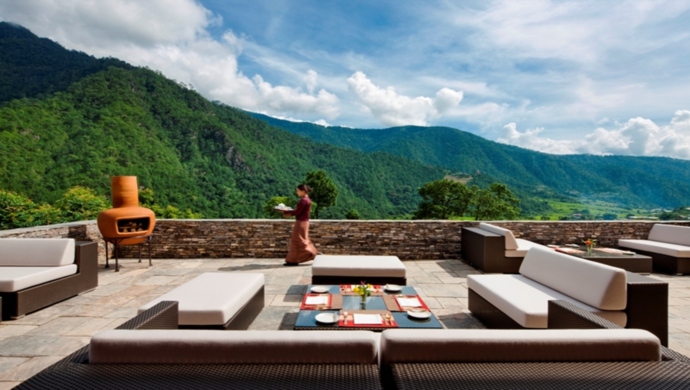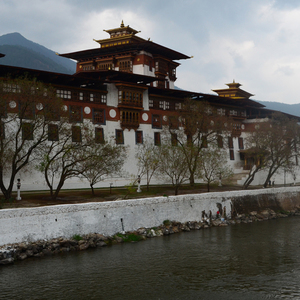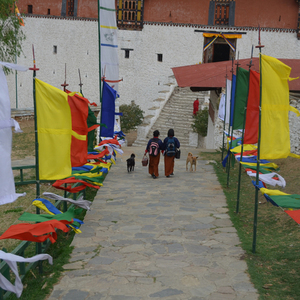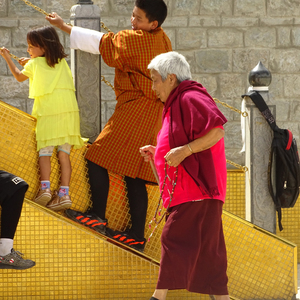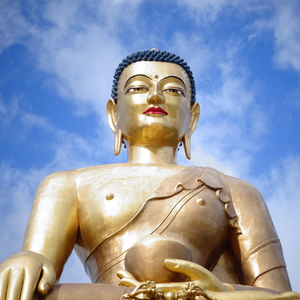Day 1. Paro - Thimphu:
Driving Distance: 65 Kms, Driving time: 1.50 Hrs - 2 Hrs, Altitude of Thimphu: 2,350 m
Your flight to Paro on a clear day, is marked with the panoramic views of the Himalayas including the Everest and other famous Peaks. The approach through the foothills and the landing (including few steep turns) at the tiny airstrip of Paro has been termed as adventurous by many travelers. After the completion of immigration formalities at the Paro Airport exit door, you will be received by your Bhutanese guide with traditional “Tashi Khadar”. Afterwards drive to Thimphu following the Pa Chhu River. Check-In to the hotel and have your first experience with Bhutanese Cuisine. Rest of the day is at leisure. You can explore the Thimphu valley and town or shop till your heart’s content. In the evening you could look into taking a dive at the indoor swimming pool.
Meals – Lunch and Dinner; Overnight at the Taj Tashi in Thimphu.
Day 2. Thimphu Sightseeing:
Today you would be driven in and around Thimphu covering key places of interest. After breakfast you would visit
- Kuensel Phodrang, the gigantic Buddha Dordenma Statue located atop a hill in Kuensel Phodrang Nature Park.
- National Memorial Chhorten, a Stupa built in 1974 to honor the third Druk Gyalpo, Jigme Dorji Wangchuck. Every morning till night old people and young people circumambulate the Chhorten. You may choose to light butter lamps and also circumambulate around the Chorten.
- Zorig Chusum, Premier institute of traditional arts and crafts in Thimphu established with an objective of preserving “thirteen arts and crafts of Bhutan”.
- Folk Heritage, traditional house giving an insight to the Bhutanese lifestyle, and artifacts from the rural households
Thereafter you would be taken to a local restaurant for lunch. In the afternoon you would be taken to
- Sangaygang View Point, also known as BBS Tower offering panoramic view of Thimphu Town situated at an elevation of 2,685 m.
- Changangkha Monastery, popular fortress like temple perched on a ridge above Central Thimphu built in 15th Century by Lama Phajo Drugom Zhipo.
- Takin Preserve Centre, see Takin (National animal of Bhutan) It is a unique combination of Goat and an Antelope
- Tashichhodzong, or ‘the fortress of the glorious religion’. Initially erected in 1641 by Shabdrung Ngawang Namgyal, it was rebuilt in the 1960s during the reign of Bhutan’s third king in the traditional style, without plans or nails. It houses some ministries, His Majesty’s secretariat, and the central monk body and opens after 5 PM.
On the completion of sightseeing, you are driven back to your hotel. After relaxing for some time you are served with dinner. While relaxing, you can choose to have a cup of tea at Rimps, the Tea Lounge in the Taj and enjoy a drink at Ara, music themed bar.
Meals – Breakfast, Lunch and Dinner; Overnight at the Taj Tashi in Thimphu.
Day 3. Thimphu - Gangtey/Phobjikha:
Driving Distance: 140 Kms, Driving time: 4 hrs - 5 hrs, Altitude of Gangtey - 2,900 m
After breakfast and completion of check out formalities, you are driven to Gangtey/Phobjikha. On the way stop at
- Dochula Pass, lies at an elevation of 3,150 m and is a great place to view the higher Himalayas. The landmarks around the pass includes 108 Druk Wangyal Stupas built under the patronage of Queen Ashi Dorji Wangmo Wangchuk.
Thereafter, you continue your drive to Gangtey/Phobjikha. While in Gangtey, visit the
- Gangtey Goemba, an important monastery of Nyingmapa school of Buddhism, the main seat of the Pema Lingpa tradition. The present Abbot, Kunzang Pema Namgyal is the ninth re-incarnation. It is one of the largest Nyingma monastery in Bhutan.
- Black Necked Crane Information Centre, a place for recreation with crane watching equipment (binoculars, spotting scopes) and reference books
After the completion of sightseeing, you are driven back to Gangtey Lodge. The view the hotel has to offer are priceless. Enjoy the view to the fullest and relax. After dinner you retire for the day.
Meals – Breakfast, Lunch and Dinner; Overnight at the Gangtey Goempa Lodge.
Day 4. Gangtey/ Phobjikha Valley Sightseeing:
A full day to explore at the
- Phobjikha Valley, one of the most beautiful glacial valleys in the Himalayas. It lies at an elevation of 3,000 m. It is surrounded by a large village inhabited mainly by the families of the 140 Gomchens who take care of the monastery. Phobjikha is best known for the rare black necked cranes that migrate here from the Tibetan Plateau to avoid the extremely cold winters.
You may choose to do any of the following: Visiting villages and interacting with People, Hikes around the valley, Photography, etc. You can also choose to hire the bike or the cycle from the hotel and go on a nature trail enjoying breathtaking views.
Meals – Breakfast, Lunch and Dinner; Overnight at the Gangtey Goempa Lodge.
Day 5. Gangtey - Punakha/Wangdue:
Driving Distance: 78 Kms, Driving time: 2.50 hrs - 3 hrs, Altitude of Punakha: 1,310 m
After Breakfast, you would check out of the hotel and get transferred to Punakha/Wangdue. After arrival at Punakha, check in to the hotel. After lunch, you would visit
- Punakha Dzong, built in 1637 by Shabdrung Ngawang Namgyal. For many years until the time of the second King, it served as the seat of the Government. It is still the winter residence of Je-Khenpo (The Chief Abbot of the Central Monastic Body of Bhutan).
- Chhimi Lhakhang, a famous Temple, which is also known as “The Temple of Fertility” built by Lama Drukpa Kuenley.
Evening free for leisure activities. You can choose to indulge yourself at the Como Shambala Retreat which offers range of holistic, Asian inspired treatments including signature massages, facials and body therapies.
Meals – Breakfast, Lunch and Dinner; Overnight at the Uma by Como, Punakha.
Day 6. Punakha - Paro:
Driving Distance: 135 kms, Driving Time: 4 hrs - 5 hrs, Altitude of Paro: 2,280 m
After breakfast, you would check out of the hotel to proceed to Paro, final leg of the tour. On the way stop at
- Royal Botanical Park, Lamperi, also known as the Rhododendron Garden, is the first Botanical Garden of Bhutan. It is famous for 46 species of rhododendrons.
After arriving at Paro, you would be transferred to you Hotel for Check In. After lunch, you would be taken around to visit
- Paro Rimpung Dzong, also known as Fortress of the heap of jewels, built during the time of Shabdrung Ngawang Namgyal in 1646.
- Ta Dzong, an ancient watch tower overlooking Rimpung Dzong built in 1951 now converted into national museum.
Return to Uma for some time to rest and relax and enjoy the facilities such as the steam rooms, swimming pool or a Bhutanese Hot Stone Bath followed by a soothing massage. Later, you are invited for a fire lit farewell dinner either in the courtyard at Uma Paro or at the Bukhari restaurant.
Meals – Breakfast, Lunch and Dinner; Overnight at Uma by Como, Paro.
Day 7. Paro Sightseeing:
After breakfast, start your day with a hike to
- Taktsang Monastery (Tiger's nest), the abode of gods and monks situated at an altitude of 3100m on the Upper Paro Valley, Bhutan. As per the legend, Guru Padmasambhana (Guru Rinpoche), the tantrum mystic who brought Buddhism to Bhutan, came in the form of Dorje Droloe riding a flying tigress to subdue the demon that was obstructing the spread of Buddhism in the Himalayas.
After the completion of the hike, you would be served picnic Lunch among the woods. After lunch, visit
- Kyichu Lhakhang, one of the oldest monasteries in Bhutan built in the 7th century by the Tibetan Emperor Songtsen Gampo.
After arriving at the hotel, you can spend the rest of the day relaxing around the property, enjoying the facilities or perhaps trying some other activities like the Bhutanese national sport of archery.
Meals – Breakfast, Lunch and Dinner; Overnight at Uma by Como, Paro.
Day 8. Departure:
Today we will bid farewell to this beautiful country and take an early flight back. We hope by now you must have made some good friends and also have taken photographs and beautiful memories of Bhutan. We certainly hope of serving you again on your next visit to this great country or the Last Shangri-La. Tashi Delek.
